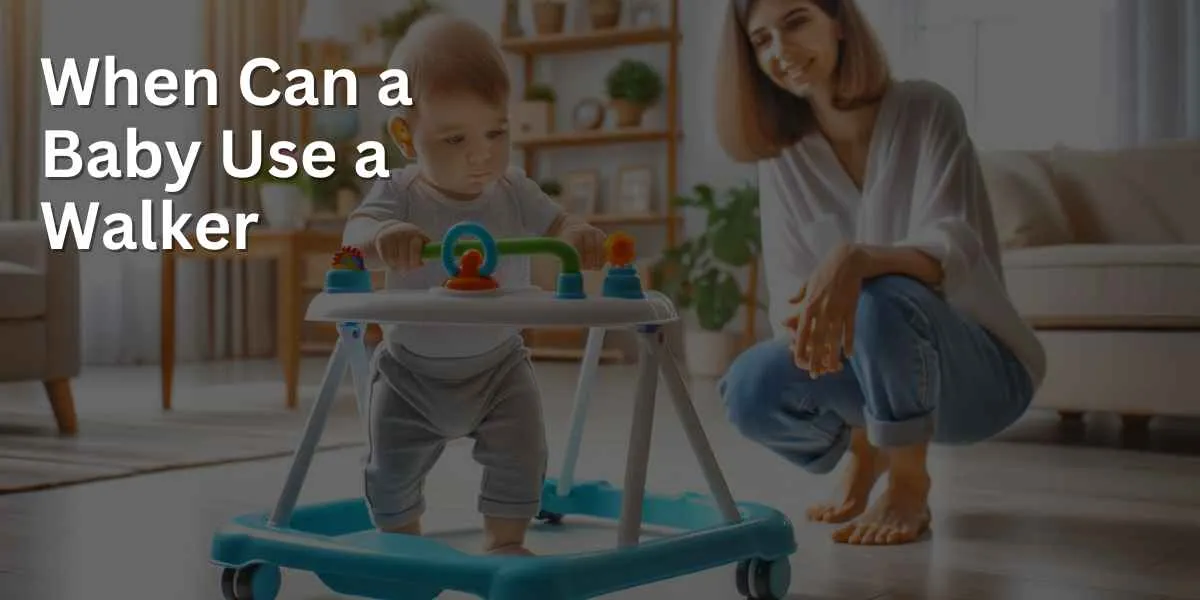Baby walkers have been a popular tool for parents for decades, providing an easy way for babies to move around and explore their surroundings. However, there is still a very hotly debated question amongst parents; when can a baby use a walker safely?
A baby can typically go in a walker when they are able to sit up without assistance and have control over their neck muscles, which usually happens around 6-9 months of age. However, it’s crucial that their feet can touch the ground when seated in the walker to promote proper development.
Despite this guideline, each baby develops at their own pace, so it’s vital to observe your child’s readiness. Infant walkers should be used sparingly and never without adult supervision, as over-reliance can hinder natural mobility progression.
When Can A Baby Use A Walker
While there is no fixed appropriate age for a baby to use a walker, the baby’s strength, development, and size will have to be considered before making a decision.
| Age Range | Developmental Milestones | Appropriate Walker Use |
|---|---|---|
| 0-6 Months | Developing head and neck control, starting to roll over | Not suitable for walker use |
| 6-9 Months | Sitting without support, starting to crawl | Not suitable for walker use |
| 9-12 Months | Pulling up to stand, cruising along furniture | May begin to introduce walker, ensuring baby’s feet touch the ground |
| 12-18 Months | Starting to walk independently, improving balance | Walker can be used for additional support if needed |
| 18+ Months | Walking independently, refining balance and coordination | May use a walker for play, not for walking support |
Age Range
Most baby walkers are designed for babies between the ages of 4 to 16 months. However, keep in mind that every child’s developmental milestone is different, and some babies may not be ready for a walker until his or her head later.
At the minimum, a baby must be able to hold their head up steadily and have their feet touch the floor to appropriately use a walker.
Baby’s Feet
Baby’s feet touching the ground before using a walker is crucial for their developmental milestones. It fosters muscle strength, coordination, and balance, crucial for walking independently. Being grounded allows babies to understand and control their movements better, building confidence and spatial awareness.
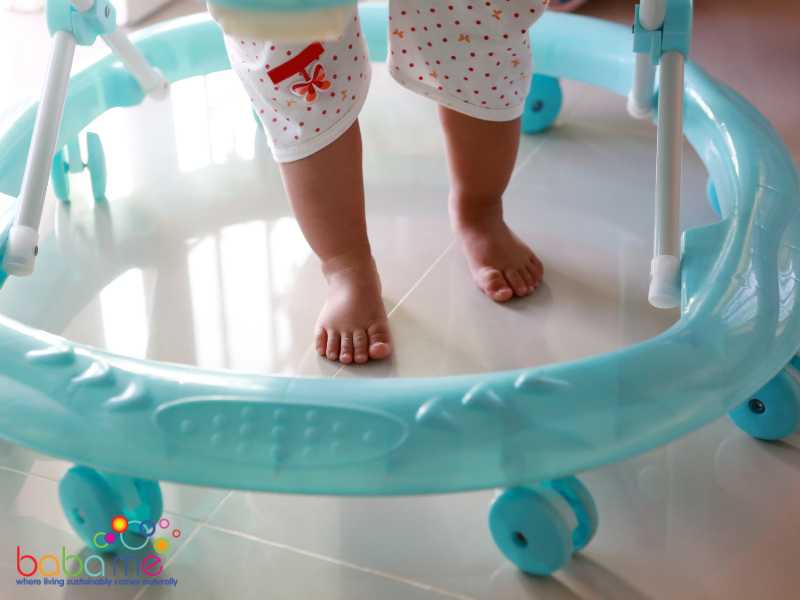
Using a walker prematurely may hinder these essential developments, leading to a delay in walking independently. It’s imperative to ensure that babies can feel and manipulate their environment with their feet before introducing aids like walkers.
Physical Readiness
Physical readiness is another important factor to consider when introducing a walker. The baby should have developed sufficient strength and coordination to support their own weight and move their legs in a walking motion. The baby should be able to sit up on their own and have good balance to prevent falls.
Check Readiness
Ensure your baby is ready for a walker. They should be able to sit up independently and have strong neck control. Their feet should be able to touch the ground while seated in the walker.
Choose the Right Walker
Look for a walker that is sturdy, has a wide base for stability, adjustable height settings, and safety features such as speed controls or brakes. If it has educational toys, ensure they are age-appropriate.
Safety First
Baby-proof the area where your child will use the walker. Remove sharp objects, secure loose rugs, and block off stairs. Always supervise your baby when they’re in the walker.
Limit Time
Avoid leaving your baby in the walker for prolonged periods. Experts recommend no more than 15-20 minutes at a time. Remember, floor time is essential for their development.
Balance With Other Activities
Ensure that walker time is balanced with plenty of opportunities for crawling, standing, and eventually walking independently. This aids in muscle development and coordination.
Patience & Encouragement
Every child develops at their own pace. Be patient, offer lots of praise and encouragement, and make the experience enjoyable.
Regular Checks
Regularly check the walker for any wear and tear or potential hazards, like loose screws or small detachable parts. Safety should be the top priority.
Benefits of Using a Walker
A walker does not just help a baby walk, it can help many other aspects of baby’s life and development:
Motor Skills Development: A walker can help babies improve their motor skills, offering them the chance to explore their environment independently. It can help in strengthening their leg muscles and enhancing their coordination.
Balance and Stability: Using a walker can assist in the development of balance and stability. As the baby learns to take steps, they gradually become more confident and sure-footed.
Cognitive Development: Most baby walkers come with built-in learning tools such as music, bright colors, shapes, and interactive buttons. These features engage the child’s senses and stimulate cognitive development.
Confidence Building: As babies gain mobility, they start to experience a new level of freedom and self-confidence. This can foster a positive approach to learning and trying new things.
Entertainment: Walkers also serve as a source of fun and entertainment for the baby. They can keep the baby occupied and amused with integrated toys and activities.
Convenience for Parents: For busy parents, a walker can provide short periods of secure and supervised play, giving them time to attend to other tasks.
Muscle Development: One of the main benefits of using a baby walker is that it can help with muscle development. As babies move around in the walker, they are using their leg muscles to push themselves forward.
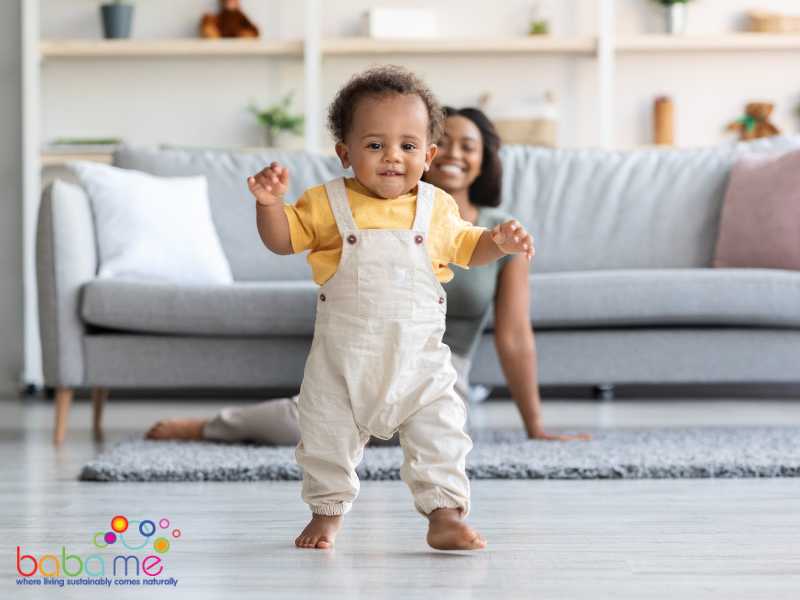
Early Childhood Education
Baby walkers, particularly those equipped with engaging educational features, can be advantageous tools in early childhood education. Many modern walkers come with integrated learning toys that stimulate a child’s sensory development and cognitive skills.
These may include musical elements, textured surfaces, and colorful shapes, letters, or numbers that encourage learning and exploration.
For instance, when a child presses a button and it causes a sound, they start understanding cause and effect. Brightly colored and differently textured attachments can enhance visual and tactile acuity.
Walkers with alphabets and numbers can also help familiarize babies with early literacy and numeracy concepts, paving the way for more structured learning in the future.
Walkers can indirectly foster socio-emotional learning. As babies gain mobility, they experience a new level of independence and self-confidence. The motivation of being able to move and explore on their own can instill a positive attitude towards learning and trying new things.
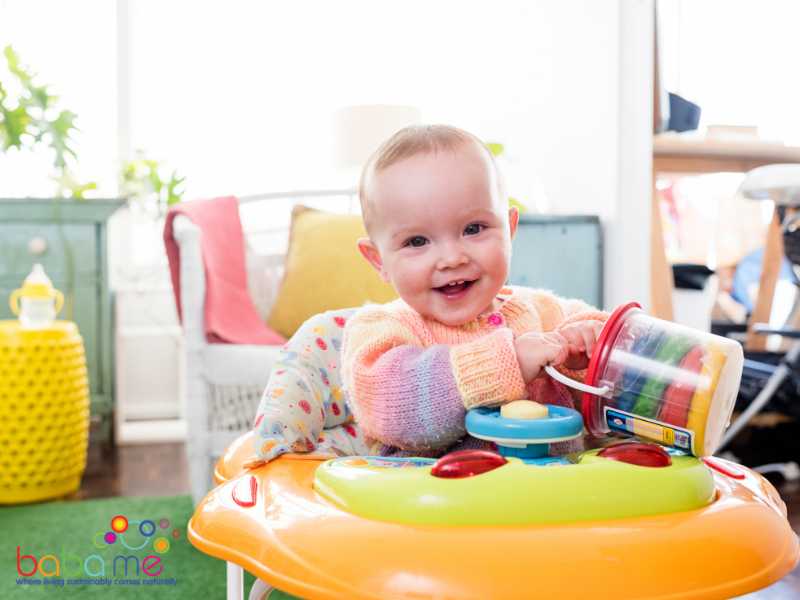
Risks and Safety Concerns
Injury Risks
Are baby walkers safe? Infant walkers can be dangerous and lead to serious baby walker injuries.
Children in walkers can get their fingers caught, pull things down on themselves, or grab dangerous things that would otherwise be out of their reach. They can fall out of walkers and get hurt or even drown when they scoot into a pool or spa.
Using a baby walker correctly is essential in order to keep your little one safe.
Even if parents are watching their children closely, accidents can happen in a split second, as baby tips a hot tea or something on themselves.
The American Academy of Pediatrics has called for a ban on the manufacture and sale of baby walkers with wheels. While some newer models have been designed with safety features such as brakes or being unable to fit through most doors, they still pose significant risks.
Supervision
It is important to supervise children closely when they are in a walker. Parents should never leave their child unattended in a walker, even for a moment. Walkers can move quickly, and children can reach higher and move faster than they would be able to otherwise.
Parents should also ensure that the walker is being used on a flat and even surface, and that there are no hazards in the immediate environment such as stairs or sharp objects.
Environment
Parents should also be mindful of the environment in which their child is using the walker. Walkers should only be used indoors on flat surfaces, and never outside or on uneven terrain.
Parents should also ensure that there are no hazards such as electrical cords or hot objects within reach of the child.
It is also important to keep the walker away from pools or other bodies of water, as children can quickly scoot into them and drown. Remember to remove sharp and pointed objects that could be within reach of your baby.
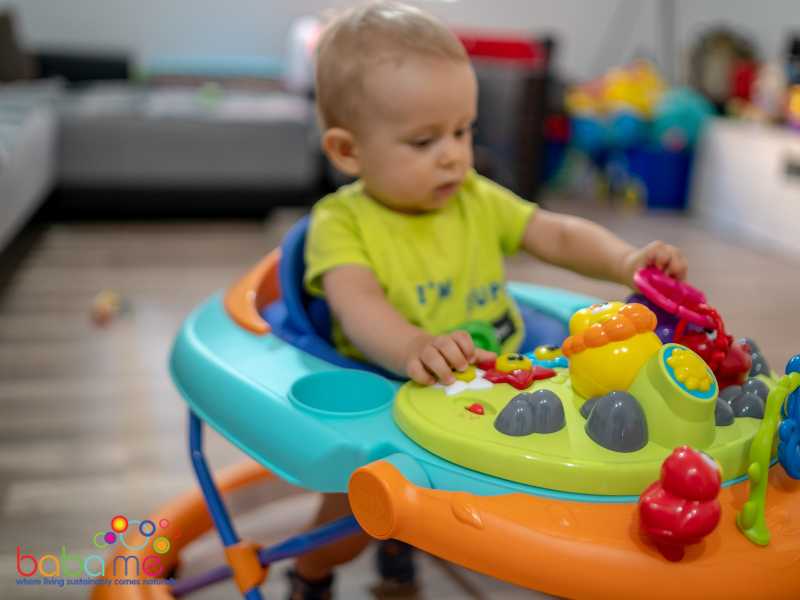
Concerns
Concerns about baby walkers are primarily for 2 reasons. One that babies are suddenly mobile and much higher up than they would be otherwise which can, and it would seem frequently does lead to accidents including burns and scalds, falling down steps, crushing fingers, and pulling objects on top of themselves.
Delayed Motor Skills Development: Extensive use of a baby walker can hinder the natural development of motor skills. It may delay milestones like crawling, standing, and eventually, walking independently.
Safety Hazards: Walkers can pose safety risks. Babies can move quickly and access potentially dangerous areas like stairs, fireplaces, or kitchens. They might also reach higher objects, like hot drinks or sharp objects, leading to accidents.
Posture and Physical Development: Walkers allow babies to move around without proper weight-bearing on the legs. This could potentially lead to improper posture and adversely affect their physical development.
Reduced Exploration: Walkers limit the scope of manual exploration, an activity that babies engage in when crawling or cruising. This hands-on exploration is vital for their cognitive development.
Over-reliance: Babies can become dependent on the walker for mobility, which can inhibit their motivation to walk independently.
There is a misconception that being in a sit-in baby walker will help babies learn to walk.
However, the design means that babies are actually not learning to balance, can’t see their feet, are using different muscles to scoot than they need to walk, and may end up essentially hanging by the crotch for long periods which can be damaging to the development of the spine and hips.
Using a traditional push-along baby walker however encourages babies to sit and play, crawl, pull themselves up to standing, and gives stability while they are figuring out how to take their first tentative steps.
With this in mind while a modern sit-in baby walker shouldn’t be used until your baby can sit unaided and touch the floor with flat feet (and then probably only for short periods – the NHS recommends 20 minutes). A push along baby walker can be introduced whenever you like providing you are there to supervise.
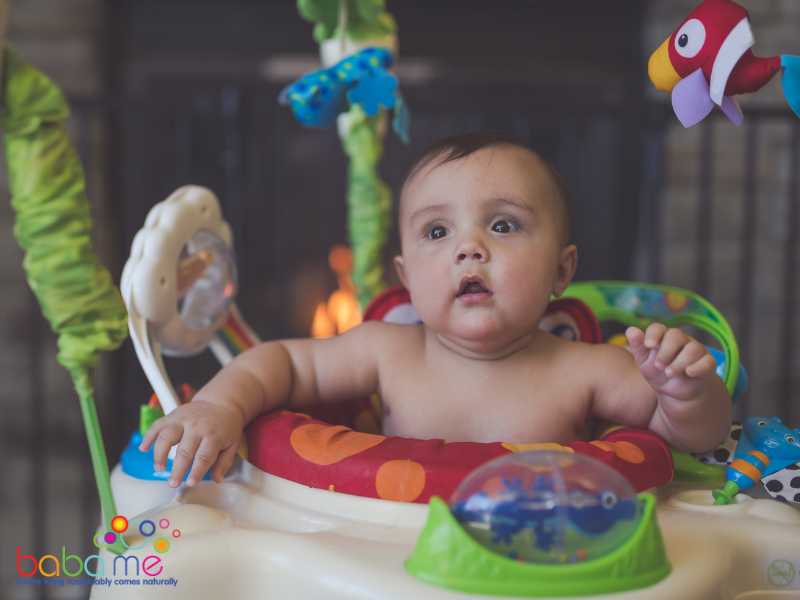
Letting your baby take the lead
Given the time and encouragement to develop their muscle strength and balance all babies will learn to walk, regardless of whether or not they have access to a baby walker. All they really need is enough time on the floor, learning to roll, then sit, crawl, and pull themselves up onto you or the furniture.
Just like baby walkers, a well-designed push along toy can be great for encouraging all these skills as well as helping build confidence and strength while they play. Using a baby walker in moderation is key! And remember that there are many cute alternatives to baby walkers out there too.
If you choose an activity walker over a baby walker you can introduce this long before babies are walking as they will love to sit in front of it and practice their fine motor skills while they play. Having the walker there as part of their surroundings means they will naturally start to pull themselves up on it when they are ready to start standing.
Obviously, unlike a table or sofa, baby walkers don’t have wheels so you need to make sure you are there to stop it rolling away from them before they are ready. Although, that being said, the learning to walk process is always going to end up with plenty of falling over.

FAQS on Baby Walker Age
When should I introduce walker to my baby?
Introducing a baby walker to your child is a personal decision, but many pediatric experts unanimously discourage the use of baby walkers due to safety concerns and potential developmental delays. Instead, parents are encouraged to allow their babies to develop motor skills at their own pace through floor play and other natural methods.
Is it OK to put my 3 month old in a walker?
It is not recommended to put a 3-month-old baby in a walker, as they are not developmentally ready for this type of equipment. It is a much better idea to let babies sit, roll and crawl around the floor before introducing a walker of any kind.
Babies should have proper head and neck control and be able to sit up independently before using a walker, ideally with the strength to at least get in to pre crawling position or be on their way to walking milestones. Moreover, baby walkers are not recommended by the American Academy of Pediatrics due to safety and developmental concerns.
Is walker good for babies?
Baby walkers are not considered good for babies as they can hinder motor and mental development. They can also pose significant safety risks, such as falls, access to dangerous objects, and even head injuries. Safer alternatives, like stationary activity centers or play yards, are recommended to promote a baby’s development without the associated risks of walkers.
Walk behind toys such as a toy pram can be a great alternative.
How long can a baby stay in a walker?
Even though the use of baby walkers is discouraged by medical experts, if a parent decides to use a walker, it should be for very limited periods. Prolonged use can hinder the natural process of learning to walk and may have adverse effects on a baby’s development. Always ensure that the baby is properly supervised while in a walker and that the environment is safe and free of hazards.
How long is to long will depend on baby’s age and where they are at developing weight bearing strength. If you are looking for an aid that will free up your arms, baby carriers are a great alternative.
Is a walker good for a 6 month old?
While some 6-month-old babies may seem physically ready for a walker, pediatric experts still advise against their use. Walkers can hinder the development of motor skills and balance, as well as pose significant safety risks. Instead, consider providing safer alternatives like stationary activity centers, which promote their motor development without the risks associated with walkers.
Are baby walkers safe for development?
Baby walkers are not considered safe for a baby’s development. Their use can hinder the development of motor skills, balance, and even cognitive abilities. It is advised against the use of baby walkers and encourage parents to opt for safer alternatives like stationary activity centers or play yards.
If you are planning to introduce a baby walker, ensure to do so in a safe and secure environment.
Are baby push walkers good for babies?
Baby push walkers can be a better alternative to traditional baby walkers, as they allow the child to develop balance and strength at their own pace. However, it is essential to ensure that the push walker is age-appropriate, stable, and used under proper adult supervision.
Parents should also be aware that different babies develop at different ages, so it is important not to rush a child into using a push walker before they are ready.
What are baby walker safety issues?
Baby walkers can present a range of safety issues if not used correctly or if the environment isn’t adequately baby-proofed:
Falls: The most significant risk is that babies can fall down stairs while in the walker, causing serious injuries. Walkers can also tip over on uneven surfaces.
Access to Dangerous Objects: With the increased height and mobility a walker provides, babies can reach objects they ordinarily wouldn’t be able to. This can include hot drinks, sharp objects, or toxic substances, leading to burns, cuts, or poisoning.
Pinch and Trap Hazards: Baby’s fingers or toes could get pinched or trapped in the walker mechanism or in a door when the baby is mobile in the walker.
Drowning: There’s an increased risk of drowning if a baby in a walker can reach a pool or bathtub.
Burns: Increased mobility could allow a baby to reach an open oven door, heater, or other hot surfaces, risking severe burns.

